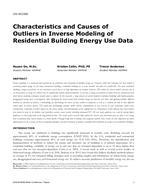Description
Inverse modeling is a commonly-used method for the prediction and evaluation of building energy use. However, while this technique has been shown to accurately predict energy use for many commercial buildings, residential building use is more variable and often less predictable. For some residential buildings, energy use patterns are not consistent, in part due to its high dependency on occupant behavior. This limits the inverse model’s accuracy due to (a) the presence of energy use outliers that lie significantly outside model predictions, or (b) due to energy use patterns of homes that are inconsistent with what inverse modeling techniques would expect as inputs. In this research, a large dataset of several hundred residential buildings with highly-granular, disaggregated energy data is investigated. After developing the inverse model with monthly energy use data for each home and applying multiple different methods for detection of outliers, a methodology for determining the causes of these outliers is proposed, as well as a solution for how to treat different outlier types in inverse models. This multi-step methodology includes outlier criteria establishment of each end-use in each household, outlier cause classification, evaluation of outlier impact on the inverse model, and determination of the appropriate use. Preliminary results indicate that most outliers were found to occur in the holiday and transition seasons; causes varied, including abnormal HVAC use, large appliance use, and/or leaving lights, appliances or other plug loads on for long periods of time. The results of this research help explain the reasons why households may use more or less energy than is predicted from inverse models in certain months Through being able to identify and categorize outliers, these results are also important for future improvements in the accuracy of inverse modeling techniques and their treatment of outliers, enabling better prediction of energy use of residential buildings.
Citation: 2018 Winter Conference, Chicago, IL, Conference Papers
Product Details
- Published:
- 2018
- Number of Pages:
- 10
- Units of Measure:
- Dual
- File Size:
- 1 file , 1.5 MB
- Product Code(s):
- D-CH-18-C050




